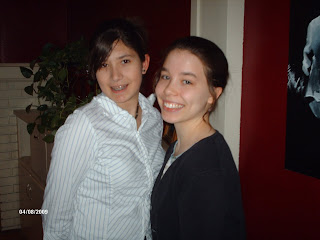
Thursday, April 30, 2009
A Relaxing Retreat

Wednesday, April 29, 2009
Free Treats on Your Birthday!

And who wouldn't want those? Check out Free Birthday Treats.com for a list of stores and restaurants near you that give out free stuff for your special day.
Enjoy!

Tuesday, April 28, 2009
My First Pillowcase Dress


+ this tutorial from EverythingSewing.net
=
Monday, April 27, 2009
Sunday, April 26, 2009
Bloggy Questionnaire

Friday, April 24, 2009
I'm Now Transferring You to the Laundry Room

Wednesday, April 22, 2009
How Does A Cavity Happen?

Taken From Biology - God's Living CreationThe Life and Death of Teeth
God designed permanent teeth to last a lifetime; therefore, with proper
nutrition and good dental hygiene, your teeth can remain strong and
attractive. The ages from thirteen to eighteen are a critical time for
oral health because decay, which occurs most often during these years, causes
the permanent teeth to be damaged. Tooth decay, or dental
caries (commonly known as cavities), is the most common disease in
man. The decay process begins when sugar mixes with plaque, a sticky, colorless film of bacteria (Streptococcus
mutans) that is constantly forming on and between the teeth. Bacteria
in plaque break down the sugars in foods to produce energy, forming lactic acid
as a byproduct; the acid is trapped against the surface of the teeth by the
sticky plaque. (Starches such as breads and crackers can also cause tooth
decay if left in the mouth for long, because the mouth's digestive enzymes
break down the starches into sugars that the bacteria can use.) After many acid
attacks, tiny holes may be formed in the enamel, allowing the acid to attack the
much softer dentine beneath the enamel. Once the protective enamel is
penetrated, cavities may be formed relatively quickly. A toothache will
occur when the decay reaches the nerves at the core of the tooth.
It is not primarily the amount of sugars consumed which causes
dental caries, but rather how often they are consumed and how
long they remain in the mouth. Each time sugar-rich foods are
consumed, more acid forms on the teeth. Sweet foods which remain in the
mouth for long periods of time - such as hard candy and sugar-sweetened chewing
gum - allow acid to remain on the teeth even longer. Sticky sweets such as
raisins and other dried fruits, mints, toffee and caramel desserts, and peanut
butter and jelly sandwiches are very harmful if they are allowed to remain on
the teeth; acid could be attacking the teeth all day long. If
sugar-sweetened soft drinks are sipped in small amounts throughout the day, the
sugars may likewise allow bacteria to attack the tooth enamel all day.
Plaque is even more harmful if allowed to remain on the teeth for
twenty-four hours; extended neglect or improper oral hygiene can result in periodontal [gum] disease. Any plaque which is not
removed by daily brushing and flossing begins to build up and form a hard
deposit called tartar (known medically as calculus). When plaque and tartar accumulate, the gums become
tender and inflamed and are likely to bleed easily when the teeth are
brushed. This periodontal disease is known as gingivitis;
if left untreated, the infection can cause periodontitis, as
disease in which the gums detach from the teeth and eventually the boned
supporting the teeth are destroyed.
Healthy teeth and gums are important for good nutrition, and good nutrition
is important for for healthy teeth and gums. A poor diet can weaken the
gums and bones which support the teeth, making them more susceptible to
periodontal disease. If sugar-rich foods are limited to mealtimes, the
saliva which is flowing readily by the end of a meal helps to dilute the acid
caused by bacteria. Brushing your teeth immediately after every meal to
remove acid-forming plaque will also help preserve your teeth from decay; loss
of teeth from periodontal disease can be prevented by regularly flossing your
teeth and visiting the dentist periodically to have any tartar buildup
removed. If you remove plaque daily, eat a balanced diet, and reduce or
eliminate the consumption of sugar between meals, your teeth can last a
lifetime.
Monday, April 20, 2009
Rag Curls

Tuesday, April 14, 2009
Airplane Cake Tutorial

Remember when I made those three cakes in March? Well, this airplane cake was one of them. It was a fun and very easy cake to do, so I thought I might use it as a tutorial for any ladies who are interested in cake decorating, have the basic supplies, but aren't quite sure how start. This cake is very simple and doesn't take a ton of time, but also gives you good practice and, of course, a cake you can blog about in the end. :)
Here's what you're going to need. I suggest you make the cake and icing and set out your supplies a day ahead of time just so you don't get overwhelmed, and so that when you go to decorate you'll have a nice clean area to work in. :)
- A cake - I used a 9 in. one
- Icing - Go here to get the icing recipe I use.
Make one recipe in thin consistency (It says do milk or corn syrup, but I suggest you do both.) Color it light blue.
Make another recipe of icing, this time doubling it and making it medium consistency. Take about a cup and a half out of the bowl and set it aside, labeling it "medium consistency". Now, add 3 1/2 Tbsp. more milk to your icing in the bowl and blend it up. Take about a cup and a third of icing out of the bowl, setting it aside and labeling it "thin consistency".
Now, take out a cup and a half, color it dark blue. Lastly, set aside 3/4 cup of icing, and color it orange. You'll have some icing left over, but it'll be good to have for Just in Case. :)
As for supplies, you'll need
- A spatula for spreading frosting
- A decorating bag (four would be great, but not needed)
- Star tip number 21
- Star tip number 18
- A number 3 tip (two of them would be nice, but again, you only need one)
- A number 5 tip
- A paper outline of an airplane, the size of how you'd like it on your cake. I printed an airplane coloring page off the internet, then cut the airplane out.
- A clean, small paint brush
- Some wax paper
- Piping Gel
- A toothpick



Let the cake stand for a little bit, letting the icing form a little crust. While you're waiting, make your airplane "stamp". Cover your paper airplane outline with wax paper, and tape it to the table so it doesn't move. Put your tip 2 in the decorating bag, then fill it with about 1/4 cup of piping gel. If you like, you can use the clear decorating gel that comes in the tubes from the store.


With your dark blue icing and tip 5, pipe icing lines over the places where you want it to be blue. Then, do the same with the orange icing.

Do the same with the orange icing.

Now it's time to do the clouds. Trace some cloud shapes all over the sides of your cake. You can do it like I did and strategically place them, to cover up any messy spots. :)



You're almost done! Pipe a reverse shell border, using your star tip 21, onto the bottom of your cake (if you were using wax paper underneath it, now would be the time to take that off). Before I started on the cake, I did a few shells on a plate just to give myself a little practice before actually putting them on the cake.
Anti-Feminism... A Lovely, Godly and Feminine Thing

Sunday, April 12, 2009
Coconut Macaroons - Perfect for Passover!
 For snacks we like muffins and cookies, fish crackers and Fig Newtons, snack mix and granola bars (of course all of them always pared with something fruitish :); So you can imagine that it is somewhat a challenge for us to find good Passover snacks. For the past few years, along with trail and dried fruit mix, macaroons have been a delicious snack staple. They're great because they contain no flour (which has natural leavening ingredients) - so they're perfect for Passover! If you've never made them before, or maybe aren't even celebrating Passover, you should definitely try them out! Here is a wonderful, melt-in-your-mouth recipe that we've been using for a few years now.
For snacks we like muffins and cookies, fish crackers and Fig Newtons, snack mix and granola bars (of course all of them always pared with something fruitish :); So you can imagine that it is somewhat a challenge for us to find good Passover snacks. For the past few years, along with trail and dried fruit mix, macaroons have been a delicious snack staple. They're great because they contain no flour (which has natural leavening ingredients) - so they're perfect for Passover! If you've never made them before, or maybe aren't even celebrating Passover, you should definitely try them out! Here is a wonderful, melt-in-your-mouth recipe that we've been using for a few years now.Saturday, April 11, 2009
The Kings Firecrackers - Jump Roping Taken to a New Level!
Friday, April 10, 2009
Our Big Passover Dinner











































